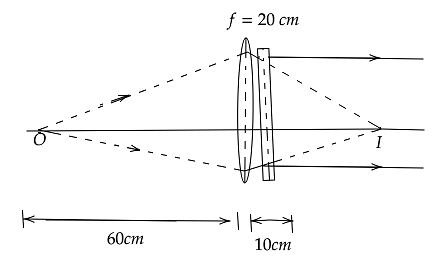
From the ray diagram show, calculate the focal length of the concave lens.


Answer
456.3k+ views
Hint: We should understand the lens formula according to the above diagram, so we know the focal length and object distance value. a ray diagram, one helpful tool that is sometimes used to portray this concept is known. So, we use the concave lens formula to find the picture distance, and we also understand the definition of focal length to evaluate the given problem.
Useful formula:
The lens formula
$\dfrac{1}{f} = \dfrac{1}{u} + \dfrac{1}{v}$
$f = $ focal length
$u = $ object distance
$v = $image distance
Complete answer:
Given by,
$u = 60\,cm$
$f = 20\,cm$
Above diagram is represented as,
A concave lens is a lens that has at least one inward-curving surface. It is a diverging lens, which means that light rays that have been refracted into it are spread out. At its middle, a concave lens is thinner than at its edges and is used to correct short-sightedness (myopia).
According to the lens formula,
$\dfrac{1}{f} = \dfrac{1}{u} + \dfrac{1}{v}$
substituting the given value in above equation,
We get,
$\dfrac{1}{v} + \dfrac{1}{{60}} = \dfrac{1}{{20}}$
On simplifying the above equation,
Here,
$\dfrac{1}{v} = \dfrac{1}{{30}}$
Now,
the relationship between the distance of an image
$v = 30\,cm$
Hence,
Focal length of concave lens is $30 - 10 = 20cm$
Note:
Since the distance between the concave mirror pole 0 and the focus F is the concave mirror's focal length. Therefore, it is possible to approximate the focal length of a concave mirror by obtaining a real image of a distant object at its focal point. A ray diagram that traces the path taken by light for a person to view a point in an object's image.
Useful formula:
The lens formula
$\dfrac{1}{f} = \dfrac{1}{u} + \dfrac{1}{v}$
$f = $ focal length
$u = $ object distance
$v = $image distance
Complete answer:
Given by,
$u = 60\,cm$
$f = 20\,cm$
Above diagram is represented as,
A concave lens is a lens that has at least one inward-curving surface. It is a diverging lens, which means that light rays that have been refracted into it are spread out. At its middle, a concave lens is thinner than at its edges and is used to correct short-sightedness (myopia).
According to the lens formula,
$\dfrac{1}{f} = \dfrac{1}{u} + \dfrac{1}{v}$
substituting the given value in above equation,
We get,
$\dfrac{1}{v} + \dfrac{1}{{60}} = \dfrac{1}{{20}}$
On simplifying the above equation,
Here,
$\dfrac{1}{v} = \dfrac{1}{{30}}$
Now,
the relationship between the distance of an image
$v = 30\,cm$
Hence,
Focal length of concave lens is $30 - 10 = 20cm$
Note:
Since the distance between the concave mirror pole 0 and the focus F is the concave mirror's focal length. Therefore, it is possible to approximate the focal length of a concave mirror by obtaining a real image of a distant object at its focal point. A ray diagram that traces the path taken by light for a person to view a point in an object's image.
Recently Updated Pages
Master Class 12 Economics: Engaging Questions & Answers for Success

Master Class 12 Maths: Engaging Questions & Answers for Success

Master Class 12 Biology: Engaging Questions & Answers for Success

Master Class 12 Physics: Engaging Questions & Answers for Success

Master Class 12 Business Studies: Engaging Questions & Answers for Success

Master Class 12 English: Engaging Questions & Answers for Success

Trending doubts
What is the Full Form of PVC, PET, HDPE, LDPE, PP and PS ?

What are the major means of transport Explain each class 12 social science CBSE

Draw a neat and well labeled diagram of TS of ovary class 12 biology CBSE

When was the first election held in India a 194748 class 12 sst CBSE

What is pseudocoelom Where is it located class 12 biology CBSE

State the postulates of special theory of relativi class 12 physics CBSE




